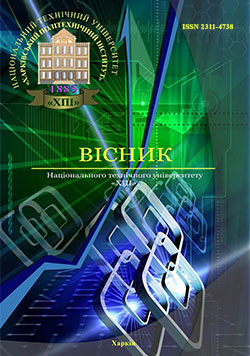COGNITIVE MODEL OF PORTFOLIO OF PORTS INFRASTRUCTURE SAFETY PROJECTS MANAGEMENT
DOI:
https://doi.org/10.20998/2413-3000.2017.1225.3Keywords:
cognitive model, portfolio of projects, risk, seaports infrastructureAbstract
Based on the concept of proactive program-oriented management and acceptable risk theory proposed a cognitive model of project portfolio management, which allows the decision maker to analyze the progress of the portfolio and the effectiveness of changes in its structure. As a cognitive model used a cognitive map of the situation, which represents basic laws and regularities of the observed situation as an oriented signed graph to the portfolio manager. The vertices of the graph are the factors (symptoms, characteristics of the situation), and arcs between them are cause-effect relationships. Each arc has a weight that reflects the factors strength of influence on each other. There are two types of cause-effect relationships: positive and negative. With a positive value of the coefficient increasing of cause-factor value leads to increasing effect-factor value, with negative - to decreasing. The article shows the result of using the cognitive model to assess the effectiveness of the implementation of safety projects portfolio at seaports.
References
1. Ivanov RudenkoY. S., Shakhov A. V. Programno-tsiloveupravlinnyabezpekoyufunktsionuvannyamorskihportiv [Program target management of safe operation in maritime ports].Materiali IХ mizhnar. nauk.-prakt. konf. «Upravlinnya proektami: stan ta perspektivi» [Materials of the IХ Int. Scien.-Pract. Conf. «Project Management: Status and Perspectives»].Mikolayiv, NUKPubl., 2013, pp. 278–280.
2. The Standard for Portfolio Management. Third edition. Project Management Institute. PMI, 2013. 189 p. ISBN 9781935589693.
3. Kendall G. I., Steven R. K. Modern methods of project portfolio management and project management office. New York, J. Ross Publishing, 2000. 589 p. (Rus. ed.: Kendall G., Rollinz S. Sovremennyie metodi upravleniya portfelyami proektov i ofis upravleniya proektami. Moscow, PM Soft Publ., 2004. 576 p.).
4. Russell Archibald D. High-technology programs and projectsmanagement. New York, John Wiley & Sons, 2003. 452 p. (Rus. ed.: Archibald R. Upravlenie vyisokotehnologichnyimi programmami i proektami. Moscow, PM Soft Publ., 2004. 472 p.).
5. Benko Kathleen D., McFarlane Uorren F. Project portfolio management. New York, J. Ross Publishing, 2000. 272 p. (Rus. ed.: Benko K., McFarlane U. Upravlenie portfelem proektov. Moscow, PM Soft Publ., 2007. 245 p.).
6. Matveev A. A.,Novikov D. A., Tsvetkov A. V. Modeli i metodyi upravleniya portfelyami proektov [Models and methods of project portfolio management]. Moscow, MGU Publ., 2005. 206 p.
7. Matveev A. A., Novikov D. A. Modeli i metodyi formirovaniya portfelya proektov [Models and methods of formation of a portfolio of projects]. Sb. trudov mezhdunar. konf. «Informatsionnaya ekonomika» [Proc. of the Int. Conf. «Information economy»]. Moscow, MGU Publ., 2005, pp. 138–149.
8. Korhina I. A. Modeli formuvannya optimalnogo portfelyu proektiv rozvitku pidprieEmstv za finansovimi kriteriyami v umovah neviznachenosti: avtoref. dys. nazdobuttyanauk. stupenyakand. tekhn. nauk: spets. 05.13.22 "Upravlinnya proektamii programami"[Models of forming of optimal project portfolio of businesses by financial criteria in uncertainty. Abstract of a thesis candidate eng. sci. diss. (Ph. D.) 05.13.22 "Project and programs management"]. Dnipropetrovsk, 2015. 23 p.
9. Shahov A. V., Shamov A. V., Bokareva M. A. Energeticheskie modeli upravleniya proektnymi organizaciyami [Energy models of project organizations management]. Saarbruken, LAP, 2015. 185 p.
10. Onischenko I. I. Kognitivne modeliuvannya yak metod yakisnogo analizu rizikiv IT-proektiv [Cognitive model– method of analyze of IT-projects]. Visnik NTU KHPI Kharkiv. 2016,no. 2 (1174), pp. 77–81.doi: 10.20998/2413-3000.2016.1174.17.
11. Rudenko Y. S. Prediction of portfolio of projects state over time using mechanisms of cognitive modeling. Proc. of the Int. Conf. “Black Sea accidents – analysis of reasons and consequences”. Burgas, 2015, pp. 104–112.
Downloads
Published
Issue
Section
License
Copyright (c) 2017 Евгений Сергеевич РУДЕНКО, Сергей Васильевич РУДЕНКО, Анатолий Валентинович ШАХОВ

This work is licensed under a Creative Commons Attribution-NonCommercial-ShareAlike 4.0 International License.
Our journal abides by the Creative Commons copyright rights and permissions for open access journals.
Authors who publish with this journal agree to the following terms:
Authors hold the copyright without restrictions and grant the journal right of first publication with the work simultaneously licensed under a Creative Commons Attribution-NonCommercial-ShareAlike 4.0 International License (CC BY-NC-SA 4.0) that allows others to share the work with an acknowledgement of the work's authorship and initial publication in this journal.
Authors are able to enter into separate, additional contractual arrangements for the non-commercial and non-exclusive distribution of the journal's published version of the work (e.g., post it to an institutional repository or publish it in a book), with an acknowledgement of its initial publication in this journal.
Authors are permitted and encouraged to post their published work online (e.g., in institutional repositories or on their website) as it can lead to productive exchanges, as well as earlier and greater citation of published work.

